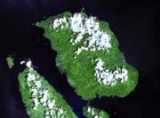
Biliran Island
Encyclopedia
- This article is about the volcanic island. For the municipality, see Biliran (municipality). For the province, see Biliran (province).
Biliran is a volcanic island in the central Philippines. It is one of the active volcanoes in the Philippines
Active volcanoes in the Philippines
Active is commonly termed for volcanoes with historical eruptions. Moreover, the Philippine Institute of Volcanology and Seismology classify active volcanoes in the country as having erupted within historical times , with accounts of these eruptions documented by man; or having erupted within the...
.
- Classification: Active
- Current Summit Activities: Solfataric
- Province: Biliran Region VIII
- Nearby Cities/Towns:
- Kawayan, BiliranKawayan, BiliranThe word kawayan means bamboo.Kawayan is a 5th class municipality in the province of Biliran, Philippines. According to the 2000 census, it has a population of 17,507 people in 3,688 households.-Barangays:...
- Almeria, BiliranAlmeria, BiliranAlmeria is a 5th class municipality in the province of Biliran, Philippines. According to the 2000 census, it has a population of 13,854 people in 2,886 households.-Barangays:Almeria is politically subdivided into 14 barangays.* Caucab* Iyosan...
- Culaba, BiliranCulaba, BiliranCulaba is a 5th class municipality in the province of Biliran, Philippines. According to the 2000 census, it has a population of 11,506 people in 2,193 households.-Barangays:Culaba is politically subdivided into 17 barangays.* Acaban* Bacolod...
- Maripipi, BiliranMaripipi, BiliranMaripipi is a 5th class municipality in the province of Biliran, Philippines. According to the 2000 census, it has a population of 8,319 people in 1,562 households.-Barangays:Maripipi is politically subdivided into 15 barangays.* Agutay* Banlas* Bato...
- Naval, BiliranNaval, BiliranNaval is a 2nd class municipality in the province of Biliran, Philippines. It is the capital municipality of Biliran. According to the 2007 census, it has a population of 44,288 people in 9,575 households....
- Caibiran, BiliranCaibiran, BiliranCaibiran is a 5th class municipality in the province of Biliran, Philippines. According to the 2000 census, it has a population of 19,606 people in 3,597 households.-Barangays:Caibiran is politically subdivided into 17 barangays....
- Biliran, BiliranBiliran, BiliranBiliran is a 5th class municipality in the province of Biliran, Philippines. According to the 2000 census, it has a population of 13,817 people in 2,619 households....
- Cabucgayan, BiliranCabucgayan, BiliranCabucgayan is a 5th class municipality in the province of Biliran, Philippines. According to the 2007 census, it has a population of 18,799 people in 3,372 households....
- Topo Sheets: 3854 I, 3855 II, 3955 III, 3854 II, 3954 III
Physical features
- Hotsprings:
- Central Biliran - Libtong Thermal Areas (12 hot springs and one bubbling pool)
- North Biliran - Panamao Thermal Area
- Anas Thermal Area
- South Biliran - Kalambis Thermal Area
- Adjacent Volcanic Edifice:
- Panamao (107 m asl)
- Gumansan (1064 m asl)
- Lauan (1187 m asl)
- Suiro (1301 m asl)
Geological features
- Rock Type: Hornblende andesite containing greenish and black hornblende
- Tectonic Setting: Biliran Volcano is part of the curvilinear belt of Quaternary volcanoes in eastern PhilippinesPhilippinesThe Philippines , officially known as the Republic of the Philippines , is a country in Southeast Asia in the western Pacific Ocean. To its north across the Luzon Strait lies Taiwan. West across the South China Sea sits Vietnam...
, parallel to Phil. Trench to the east
Volcanic activity
- Number of Historical Eruptions: 1
- Latest Eruption/Activity: September 26, 1939
- Site: crater
- Eruption Character: Debris avalanche
- Affected Areas/Remarks: Ashfall at Caibiran and adjoining areas (6.35 cm thick deposits)
- Monitoring activity: Short-term monitoring in 1954
See also
- Active volcanos in the Philippines
- Potentially active volcanos in the Philippines
- Inactive volcanos in the Philippines
- Philippine Institute of Volcanology and SeismologyPhilippine Institute of Volcanology and SeismologyThe Philippine Institute of Volcanology and Seismology is a Philippine national institution dedicated to provide information on the activities of volcanoes, earthquakes and tsunamis, as well as other specialized information and services primarily for the protection of life and property and in...
- VolcanoVolcano2. Bedrock3. Conduit 4. Base5. Sill6. Dike7. Layers of ash emitted by the volcano8. Flank| 9. Layers of lava emitted by the volcano10. Throat11. Parasitic cone12. Lava flow13. Vent14. Crater15...

